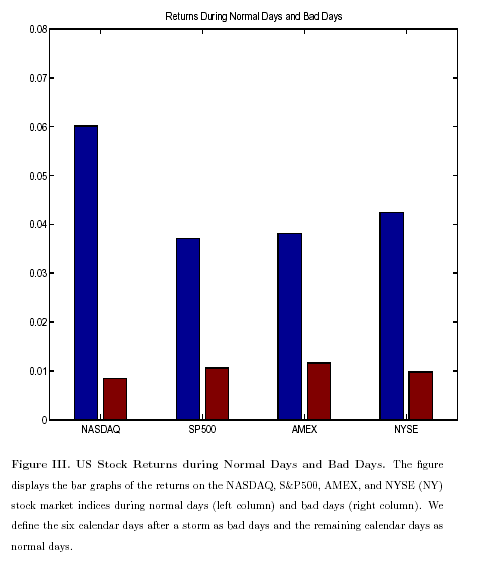Stress divers
Ap Index
Stock Market
http://www.frbatlanta.org/invoke.cfm?objectid=AFD46B63-2852-4812-BE83E6D0C777F4BF&method=display
Mots-clés: stock returns, geomagnetic storms, seasonal affective disorders, misattribution of mood, behavioral finance
Anna Krivelyova, Cesare Robotti, 10/2003
Geomagnetic Storms and the Stock Market.pdf
! Comment les 'Normal day' & 'Bad day' sont-ils définis (seuil ? période ?)
=> Bad day : si un orage magnétique frappe à t, alors, t à t+6 sont considérés comme des 'bad days'. Mais le seuil pour les 'Bad Days' n'est pas donné ...
! Pas de calcul de corrélation
Please address questions regarding content to Anna Krivelyova, Department of Economics, Boston College, 140 Commonwealth Avenue, Chestnut Hill, Massachusetts 02134, 404-869-4715, krivelyova@bc.edu, or Cesare Robotti, Federal Reserve Bank of Atlanta, 1000 Peachtree Street, N.E., Atlanta, Georgia 30309, 404-498-8543, cesare.robotti@atl.frb.org.
un lien entre l'humeur et les GMS ?
This paper provides evidence of a non negligible GMS effect on stock market returns in the United States, even after controlling for the influence of other environmental when we allow for a GARCH term in the mean equation. The magnitude of the coefficient estimates is virtually unchanged. Hence, after adjusting for risk in a CAPM framework, the GMS factor continues to be priced. 30The use of the seasonal interaction dummy substantially reduces the number of stormy days in our sample. As expected, size and precision of the coefficient estimates turn out to be smaller.
factors and well-known market seasonals. The World and several international stock market indices also appear to be negatively a�ected by geomagnetic storms during their recovery phase. This e�ect is statistically and economically significant, and seems to generate some trading gains. For the US, the GMS effect is similar across indices, ranging from -0.84 to -2.51 percent of average annual returns.
We also document a more pronounced GMS effect in the pricing of smaller capitalization stocks. We rationalize this finding by noticing that institutional ownership is higher for large cap stocks, while small cap stocks are being held mostly by individuals. Since investment decisions of individual investors are more likely to be affected by sentiments and mood than those of institutional investors, we expect the GMS effect to be more pronounced for small cap stocks.
Overall, results are consistent with some of the recent findings in the psychology literature, are robust to different measures to capture the GMS effect, and do not appear to be an artifact of heteroskedastic patterns in stock returns.
As a supporting argument, we used clinical studies showing that geomagnetic storms have a profound effect on people’s moods; and in turn people’s moods have been found to be related to human behavior, judgments and decisions about risk. By using related medical and psychological arguments, our results complement recent findings of a significant SAD effect [Kamstra, Kramer, and Levi (2003)] and of a significant sunshine effect [Hirshleifer and Shumway (2003)] in stock market returns.
This paper represents an attempt of establishing a link between psychology and economics. Future research should further explore the relation between people’s mood and behavior in a financial setting, possibly controlling for cross-country differences. Daily data on the trading behavior of mutual funds and individual investors might shed more light on the differential impact of GMS on small cap vs. large cap stocks.
